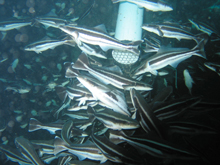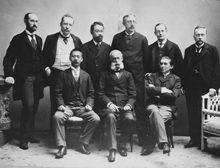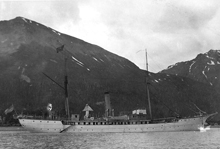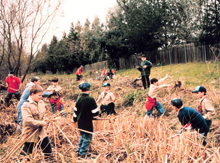The History of Fisheries Stewardship
Fisheries management is the effort to regulate where, when, and how people fish—protecting fish populations so that people can continue to fish in the future. As the federal agency responsible for marine fisheries management, NOAA works to maintain healthy stocks of fish important to commercial, recreational, and subsistence fisheries; eliminate overfishing and rebuild overfished stocks; and increase long-term economic and social benefits from living marine resources.
- Introduction
- Commission of Fish and Fisheries
- A New Century
- Shifting Challenges
- Progress and Change
- Establishing NMFS
- Conclusion

Spencer Baird, the first Commissioner of the U.S. Commission of Fish and Fisheries, directs field sampling from a boat in waters off Woods Hole in the late 19th century. Click image for larger view.
Fish. The word evokes many thoughts and images—deep-fried shrimp, a tuna sandwich, cod fillets, oysters on the half shell. Or, a salmon tugging on the line, a leaping marlin, or maybe just the slap of waves and smell of brisk sea air. But for the nation, fish have always been important, first for food and trade, often for recreation, and even as a key component of national security.
It should not be too surprising that the nation’s first federal conservation agency, formed in 1871, was devoted to the protection, study, management, and restoration of fish. This article follows the first century of fisheries management within the federal government.
Establishment of the U.S. Commission of Fish and Fisheries
Although the U.S. Commission of Fish and Fisheries was created in 1871, the roots of the U.S. Fish Commission lie even deeper in the nation's history. Secretary of State Thomas Jefferson discussed federal interest in fisheries in 1791, noting how fishermen had been devastated during the Revolutionary War and reviewing their importance in trade.

Nineteenth century biologists at the U.S. Commission on Fish and Fisheries laboratory in Woods Hole, Massachusetts, work from the little launch Phalarope. Click image for larger view.
In recognition of the importance of fisheries to the U.S. economy, Congress created the U.S. Commission of Fish and Fisheries on February 9, 1871. Its first Commissioner was Spencer Fullerton Baird and its headquarters were established in Woods Hole, Massachusetts.
The Nation’s First Marine Ecological Studies
Congress first charged the Fish Commission to study the reasons for the decline of several New England and lake fishes and to recommend solutions. When he entered his position, Baird was already well aware of problems with New England fisheries and he recognized that there would be no simple answers to these problems.
Except in the areas of sounding and charting of the sea coasts, knowledge of the nation’s seas, and especially its fish and fisheries, was scant. Keenly aware of those deficiencies, Baird quickly initiated the nation’s first marine ecological studies. As he put it, studying only the fish “would not be complete without a thorough knowledge of their associates in the sea, especially of such as prey upon them or constitute their food.”
An New Endeavor: Fish Culture

These cobia at a Puerto Rican offshore aquaculture facility represent the fulfillment of colonial America’s aquaculture dream. Click image for larger view.
One year after its establishment, Congress gave the Fish Commission a new task: fish culture. By then, interest in fish culture was growing, and it was widely seen as a cure-all for decimated New England Atlantic salmon and shad runs. Much of the Commission’s efforts to promote fish culture were rooted in the concept that it was far better to make fish abundant and cheap so they could be fished with fewer restrictions than to just pass stricter laws to protect fewer and fewer fish.
State Fish Commissions
The new Fish Commission not only gave American fish culture a strong boost, it also spurred the establishment of state fish commissions. In 1871, there were only 11 small state fish commissions, but, just six years later, 26 state fish commissions were operating. In large part, this growth was due to Baird’s advocacy of state commissions for more effective fish cultural work. Even today, commissions are critical to managing and conserving our shared coastal fisheries within the first three miles of the nation's coastline.

Early efforts at seal harvest regulations came from the 1897 International Seal Conference, which included famed American scientist David Starr Jordan (standing, fourth from left) and former Secretary of State John W. Foster (seated, center). Click image for larger view.
By seeking to explore the “physical, natural, and economical features of the sea” as fully as possible, Baird laid important groundwork for the understanding and federal management of our fisheries resources. In fact, many of the types of work started during the Commission’s first decade are still pursued today in the protection and restoration of our fisheries.
A New Century: The U.S. Bureau of Fisheries is Born
With the turn of the century, the nation became increasingly interested in resource protection and conservation. National wildlife refuges and national forests were established and new laws were passed to protect the nation's fish and wildlife resources.
For the 30-year old Fish Commission, the new century brought a new home. Formerly independent, in 1903, the agency was renamed the U.S. Bureau of Fisheries and placed in the U.S. Department of Commerce and Labor. A year earlier, the nation's second federal marine science laboratory had been built at Beaufort, North Carolina, and in 1905, the first federal fish hatchery was established in Alaska's Yes Bay.

The first deep water federal fisheries research vessel, Albatross, saw service off the East and West coasts, and, shown here, in Alaskan waters. Click image for larger view.
While the Bureau had long worked to improve fishery marketing and product development, in 1914, the onset of World War I (WWI) and associated food shortages accelerated those studies. Bureau scientists focused on the immediate increase of aquatic food supplies. Meanwhile, the U.S. Navy commandeered the Bureau's research vessel, the Albatross, for WWI Gulf of Mexico and Caribbean Sea patrols and occupied the Bureau's Woods Hole and Beaufort Laboratories for specialized war-related research.
Shifting Challenges: The Depression and World War II

Fish canneries, such as these in the early 20th century, have provided jobs for hundreds of thousands of American men and women throughout our nation’s history. Click image for larger view.
Following the end of WWI in 1918, fisheries management entered a new era. The federal government began promoting commercial fishing, wider use of fish as economic and health measures, and improvements in food production.
The Bureau continued research into fish culture, particularly the culture of oysters. Research also began on ways to pass salmon safely around dams and water diversion projects on Pacific coast streams. During the 1930s, fish marketing and promotion efforts increased and a new fishery market news service was established. In addition, the growing role of law enforcement in fisheries management led to the creation of a “Division of Law Enforcement” within the Bureau in 1930.
Fundamental reorganization came to the agency in 1939: the Commerce Department's Bureau of Fisheries and the Agriculture Department's Bureau of Biological Survey were transferred to the Department of Interior. A year later, the fishery and wildlife units of both Bureaus were merged as “divisions” within Interior's new “Fish and Wildlife Service.”
Throughout World War II (WWII), the Bureau's research aided crucial production of foodstuffs and other critical national defense missions and operations. Federal fisheries laboratories turned their studies to ways of supplying growing needs for protein, often from unusual forms of marine life, such as sharks and other sea creatures. With the onset of the nuclear age, Bureau scientists helped make new assessments of the environmental effects of radiation and began pioneering studies of the peaceful use of irradiation to preserve seafood.
Progress and Change: An International Focus
The end of WWII marked a major milestone for U.S. and global fisheries. Prior to the war, few nations had begun moving into international waters to fish. However, that fishing effort mushroomed once the war ended. Increased fishing by European and Asian vessels and factory ships off U.S. coasts posed a challenge for scientists, commercial fishermen, and diplomats.
Increased globalization during the 1940s and 1950s continued to challenge fisheries management. New international organizations, such as the United Nations, its Food and Agriculture Organization, the International Commission for the Northwest Atlantic Fisheries, and the Inter-American Tropical Tuna Commission were established. Foreign fishermen increasingly used huge factory trawlers in “international waters,” often just three miles from U.S. coastlines.
In yet another major reorganization, the Fish and Wildlife Act of 1956 reestablished two Bureaus within a new U.S. Fish and Wildlife Service—the Bureau of Sport Fisheries and Wildlife and the Bureau of Commercial Fisheries (BCF). The new BCF was charged with helping the U.S. fishing industry locate new fishing grounds, promoting trade and marketing fish, developing new foods and products from fish, assisting with new fishing technologies and vessel financing, and more.
The 1960s ushered in an even more aggressive era of foreign factory trawler fishing near U.S. coasts. However, cooperative research between Bureau scientists and those of other nations to assess the fisheries and identify potential problems and solutions also grew.
Increased globalization brought added responsibilities for enforcement to the Bureau and marked an entirely new era that would, 25 years later, result in new federal laws, particularly the Magnuson Fishery Conservation and Management Act of 1976. These laws marked a new initiative to protect U.S. fishery interests and resources.
Establishment of the National Marine Fisheries Service

Improving fisheries habitat involves coastal communities through the NOAA Restoration Center, like this California streambed building. Click image for larger view.
In the late 1960s, the nation's interest in ecology and the environment began to grow. Concern over marine and atmospheric programs led Congress to establish the “Stratton Commission.” Based on the recommendations of this group, in 1970, NOAA was created under the Department of Commerce. The Bureau was then renamed the National Marine Fisheries Service and placed in NOAA, marking a new era for fisheries management and science in the United States.
Conclusion
Since its inception as the U.S. Commission of Fish and Fisheries in 1871, NOAA Fisheries has built a history of stewardship of the nation’s living marine resources. This tradition guides the agency’s continuing stewardship mission to manage and conserve these important national resources in a sustainable way.
As the nation has grown in environmental awareness, the scientific basis for marine research and conservation, pioneered in the 1870s by Spencer Baird, has evolved to meet the needs and objectives of today’s American public.
Today, American consumers are no longer limited to a few fish or fish products. Owing to NOAA Fisheries research, our own U.S. fish products are sold around the world in many forms, and our fish markets provide a broad variety of fresh, frozen, and prepared food products from species from around the globe. Additionally, wise management of resources will ensure that future generations will enjoy the same seafood selection for years to come.
